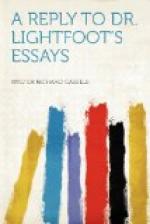Space only allows of my referring to one other instance. [30:1] Dr. Lightfoot says—
“If by any chance he condescends to discuss a question, he takes care to fasten on the least likely solution of ‘apologists’ (e.g. the identification of Sychar and Shechem), [30:2] omitting altogether to notice others.”
In a note Dr. Lightfoot adds:—
“Travellers and ‘apologists’ alike now more commonly identify Sychar with the village bearing the Arabic name Askar. This fact is not mentioned by our author. He says moreover, ’It is admitted that there was no such place (as Sychar, [Greek: Suchar]), and apologetic ingenuity is severely taxed to explain the difficulty.’ This is altogether untrue. Others besides ‘apologists’ point to passages in the Talmud which speak of ’the well of Suchar (or Sochar or Sichar);’ see Neubauer, ‘La Geographie du Talmud,’ p. 169 f. Our author refers in his note to an article by Delitzsch, (’Zeitschr. J. Luth. Theol.,’ 1856, p. 240 f.) He cannot have read the article, for these Talmudic references are its main purport.” [30:3]
I may perhaps be allowed to refer, first, to the two sentences which I have taken the liberty of putting in italics. If it be possible for an apologist to apologise, an apology is surely due to the readers of the “Contemporary Review,” at least, for this style of criticism, to which, I doubt not, they are as little accustomed as I am myself. There is no satisfying Dr. Lightfoot. I give him references, and he accuses me of “literary browbeating” and “subtle intimidation;” I do not give references, and he gives me the lie. I refer to the article of Delitzsch in support of my specific statement that he rejects the identification of Sychar with Sichem, and apparently because I do not quote the whole study Dr. Lightfoot courteously asserts that I cannot have read it. [31:1]




